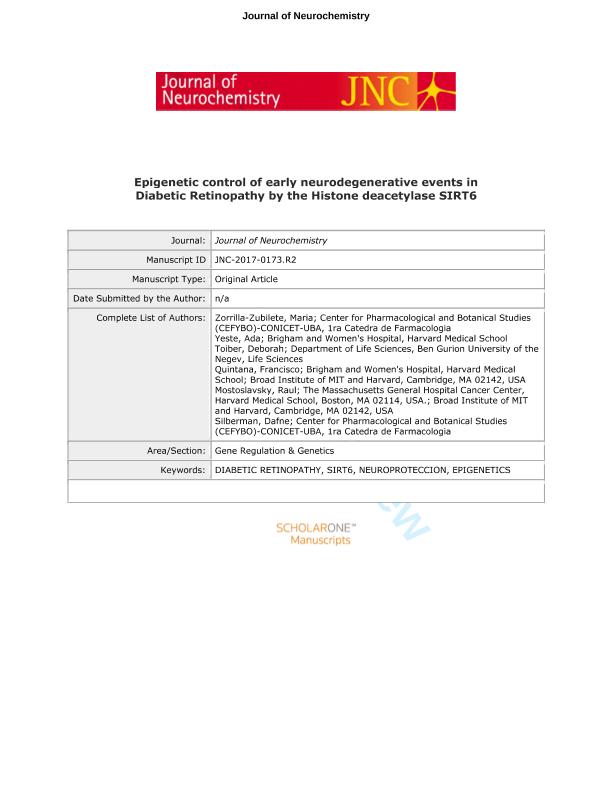Mostrar el registro sencillo del ítem
dc.contributor.author
Zorrilla Zubilete, María Aurelia

dc.contributor.author
Yeste, Ada
dc.contributor.author
Quintana, Francisco J.
dc.contributor.author
Toiber, Debra

dc.contributor.author
Mostoslavsky, Raul

dc.contributor.author
Silberman, Dafne Magalí

dc.date.available
2018-06-04T14:59:59Z
dc.date.issued
2018-01
dc.identifier.citation
Zorrilla Zubilete, María Aurelia; Yeste, Ada; Quintana, Francisco J.; Toiber, Debra; Mostoslavsky, Raul; et al.; Epigenetic control of early neurodegenerative events in diabetic retinopathy by the histone deacetylase SIRT6; Wiley Blackwell Publishing, Inc; Journal of Neurochemistry; 144; 2; 1-2018; 128-138
dc.identifier.issn
0022-3042
dc.identifier.uri
http://hdl.handle.net/11336/47125
dc.description.abstract
Diabetic retinopathy (DR) is one of the common complications associated with diabetes mellitus (DM) and the leading cause of blindness worldwide. Recent research has demonstrated that DR is not only a microvascular disease but may be a result of neurodegenerative processes. Moreover, glucose-induced neuron and glial cell damage may occur shortly after the onset of diabetes which makes the disease hard to diagnose at early stages. SIRT6, a NAD-dependent sirtuin deacylase, modulates aging, energy metabolism and neurodegeneration. In previous studies we showed that SIRT6 deficiency causes major retinal transmission defects, changes in the expression of glycolytic genes and elevated levels of apoptosis. Given the importance of glucose availability for retinal function and the critical role of SIRT6 in modulating glycolysis, we aimed to analyze SIRT6 participation in the molecular machinery that regulates the development of experimental DR. By using non-obese diabetic (NOD) mice, we determined by Western blot that two weeks after the onset of the disease, high glucose concentrations induced retinal increase of a neovascularization promoting factor (VEGF) and the loss of a neuroprotective factor (BDNF) associated with reduced levels of SIRT6 and increased acetylation levels of its substrates (H3K9 and H3K56) suggesting a deregulation of key neural factors. Noteworthy, retinas from CNS conditionally deleted SIRT6 mice showed a resemblance to diabetic retinas exhibiting lower protein levels of BDNF and increased protein levels of VEGF. Moreover, cultured Müller glial cells subjected to high glucose concentrations exhibited decreased levels of SIRT6 and increased levels of H3K56 acetylation. Additionally, the increment of VEGF levels induced by high glucose was reverted by the overexpression of SIRT6 in this cell type. Accordingly, siRNA experiments showed that, when SIRT6 was silenced, VEGF levels increased. Our findings suggest that epigenetically regulated neurodegenerative events may occur at an early diabetic stage prior to the characteristic proliferative and vascular changes observed at a later diabetic stage. This article is protected by copyright. All rights reserved.
dc.format
application/pdf
dc.language.iso
eng
dc.publisher
Wiley Blackwell Publishing, Inc

dc.rights
info:eu-repo/semantics/openAccess
dc.rights.uri
https://creativecommons.org/licenses/by-nc-sa/2.5/ar/
dc.subject
Sirt6
dc.subject
Retina
dc.subject
Epigenética
dc.subject.classification
Otras Ciencias Biológicas

dc.subject.classification
Ciencias Biológicas

dc.subject.classification
CIENCIAS NATURALES Y EXACTAS

dc.title
Epigenetic control of early neurodegenerative events in diabetic retinopathy by the histone deacetylase SIRT6
dc.type
info:eu-repo/semantics/article
dc.type
info:ar-repo/semantics/artículo
dc.type
info:eu-repo/semantics/publishedVersion
dc.date.updated
2018-06-01T19:22:34Z
dc.journal.volume
144
dc.journal.number
2
dc.journal.pagination
128-138
dc.journal.pais
Reino Unido

dc.journal.ciudad
Londres
dc.description.fil
Fil: Zorrilla Zubilete, María Aurelia. Consejo Nacional de Investigaciones Científicas y Técnicas. Oficina de Coordinación Administrativa Houssay. Centro de Estudios Farmacológicos y Botánicos. Universidad de Buenos Aires. Facultad de Medicina. Centro de Estudios Farmacológicos y Botánicos; Argentina
dc.description.fil
Fil: Yeste, Ada. Harvard Medical School; Estados Unidos
dc.description.fil
Fil: Quintana, Francisco J.. Harvard Medical School; Estados Unidos. Broad Institute of MIT and Harvard Cambridge; Estados Unidos
dc.description.fil
Fil: Toiber, Debra. Ben‐Gurion University of the Negev Beer‐Sheva; Israel
dc.description.fil
Fil: Mostoslavsky, Raul. Harvard Medical School; Estados Unidos. Broad Institute of MIT and Harvard Cambridge; Estados Unidos
dc.description.fil
Fil: Silberman, Dafne Magalí. Consejo Nacional de Investigaciones Científicas y Técnicas. Oficina de Coordinación Administrativa Houssay. Centro de Estudios Farmacológicos y Botánicos. Universidad de Buenos Aires. Facultad de Medicina. Centro de Estudios Farmacológicos y Botánicos; Argentina
dc.journal.title
Journal of Neurochemistry

dc.relation.alternativeid
info:eu-repo/semantics/altIdentifier/url/https://onlinelibrary.wiley.com/doi/abs/10.1111/jnc.14243
dc.relation.alternativeid
info:eu-repo/semantics/altIdentifier/doi/https://dx.doi.org/10.1111/jnc.14243
Archivos asociados
